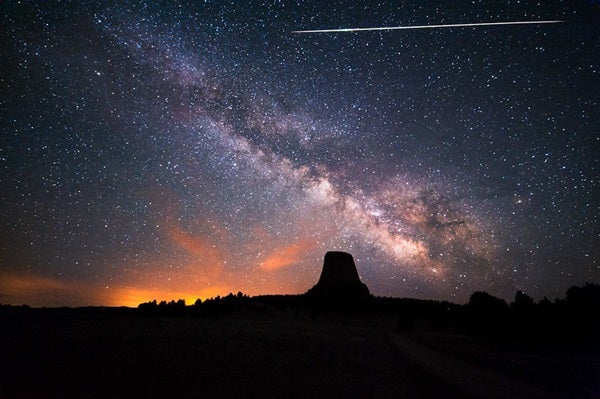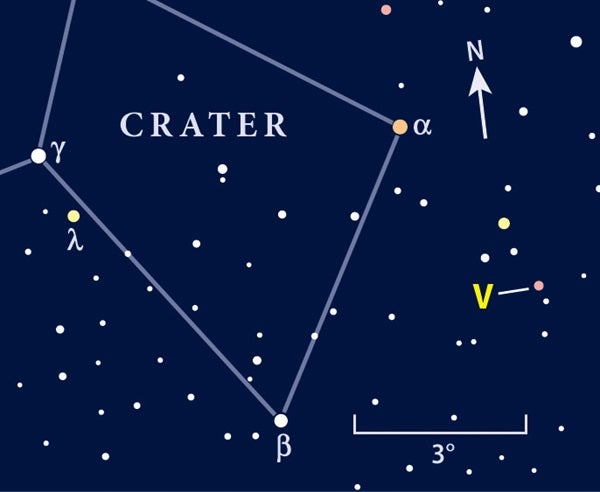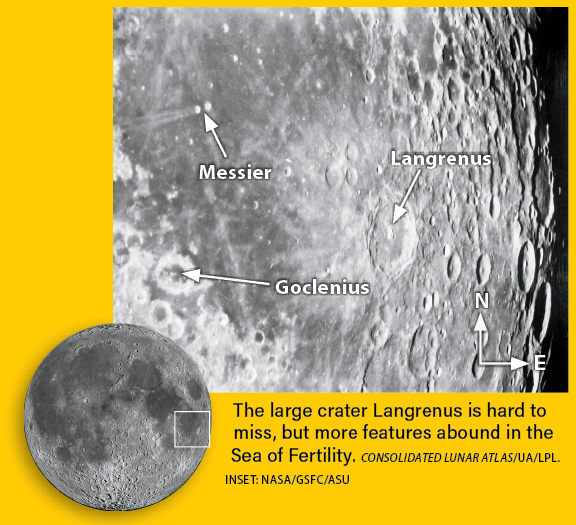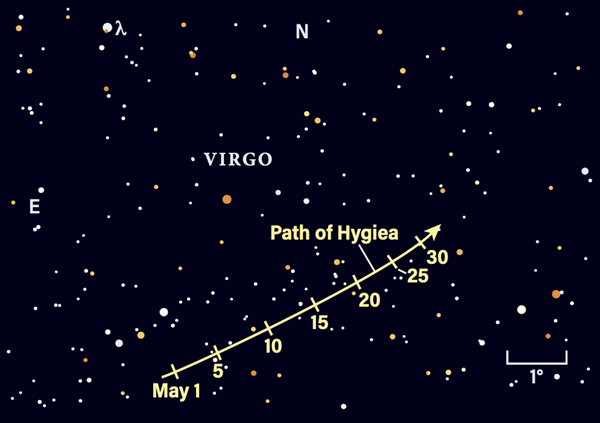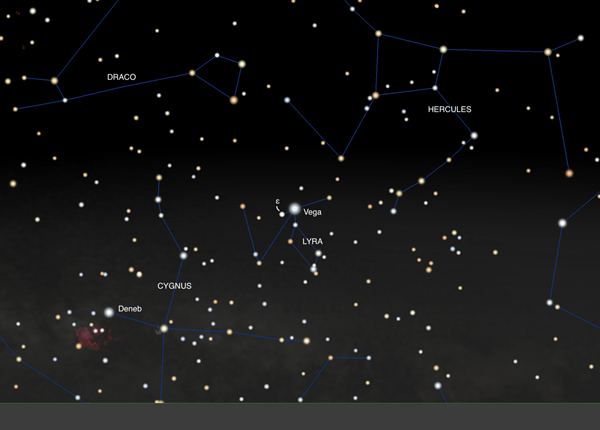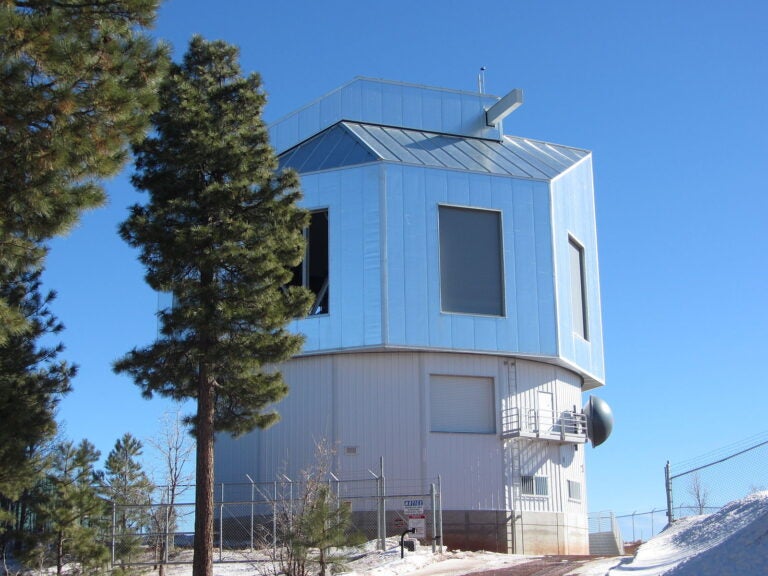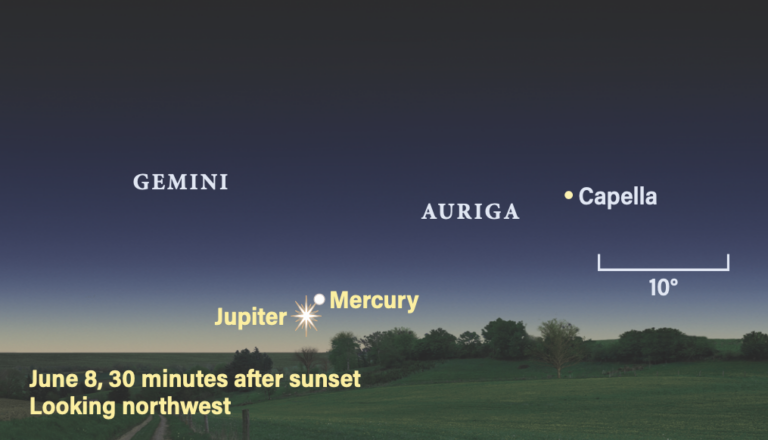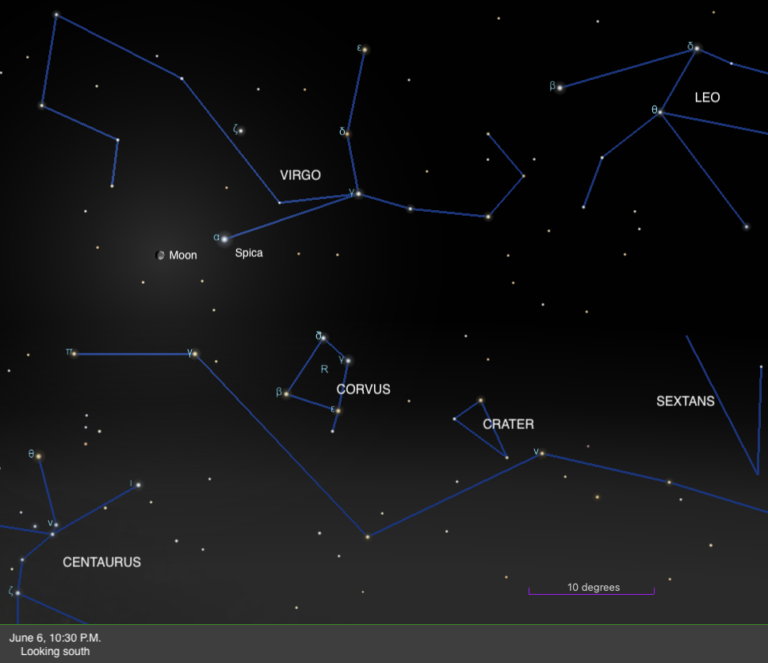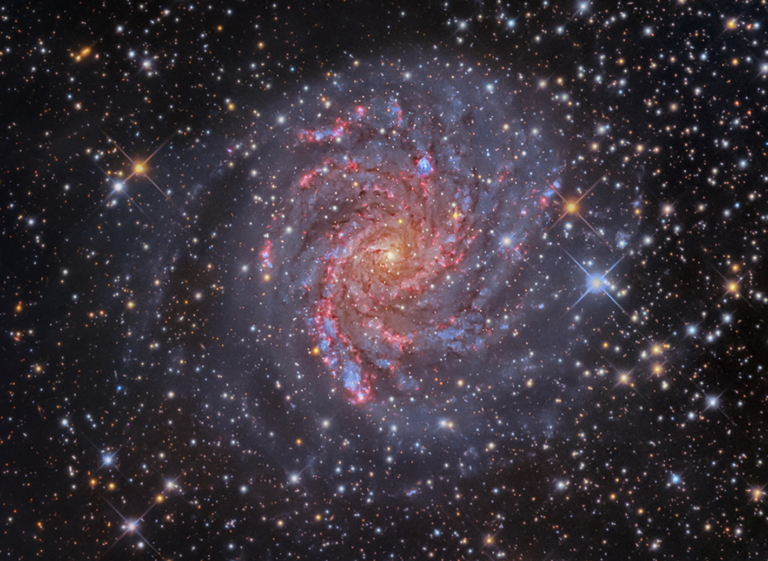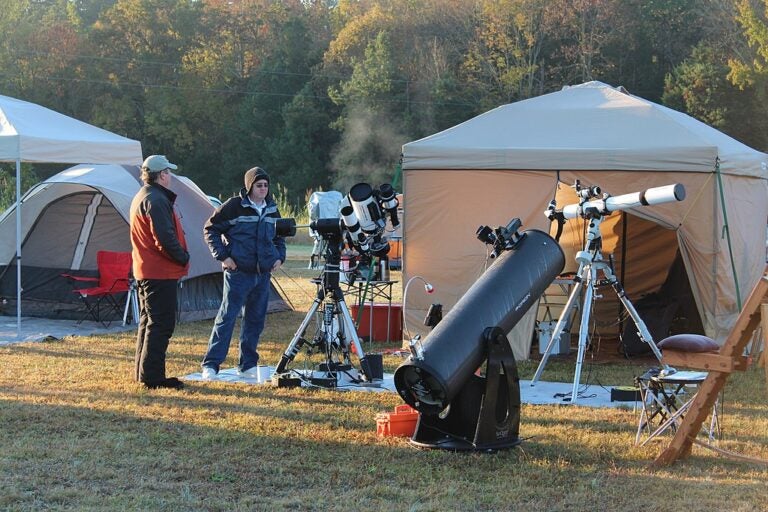Friday, May 6
The Eta Aquariid meteor shower peaks early this morning. The best time to catch its shooting stars is a few hours before dawn, when the radiant in Aquarius is highest in a moonless sky. However, this shower is active through the rest of the month and should enhance the sporadic background rate of a few per hour, even during the evening hours. The Eta Aquariids’ expected maximum zenithal hourly rate today is 50 meteors per hour, though the placement of the shower’s radiant in the sky at this time of year will reduce that number considerably.
Eta Aquariid meteors are born from dust left in the inner solar system by Halley’s Comet. When Earth passes through this trail, which sits along the comet’s orbit, we experience a meteor shower. The Orionids, which appear in October, are also the product of Halley’s leftovers still circling the Sun.
This dust and debris is responsible for another beautiful sight: the zodiacal light, which is best seen after dusk in the springtime. So, tonight after sunset, step outside and look west as the sky grows darker. You’ll need a viewing spot with little to no ground light, especially as the waxing Moon may interfere slightly. The zodiacal light, if you can catch it, should appear as a dusky, cone-shaped glow rising upward from the western horizon. It lies along the ecliptic, or plane of the solar system, and photographs quite nicely. Stick to exposures of 30 seconds or less to minimize star trails in your image.
Sunrise: 5:54 A.M.
Sunset: 8:00 P.M.
Moonrise: 9:52 A.M.
Moonset: 12:51 A.M.
Moon Phase: Waxing crescent (29%)
*Times for sunrise, sunset, moonrise, and moonset are given in local time from 40° N 90° W. The Moon’s illumination is given at 12 P.M. local time from the same location.
Saturday, May 7
Saturn currently leads the parade of early-morning planets visible right now. The ringed planet rises around 2:30 A.M. in Capricornus; two hours later, it sits roughly 20° high. Right around this time — before any hint of dawn has begun to appear — is when you want to be out this morning to catch sight of 7th-magnitude 4 Vesta, the main belt’s brightest asteroid, sitting between Saturn and the nearby bright star Deneb Algedi.
Let’s locate Saturn first — an easy magnitude 0.7 in the southeastern sky, just less than 2° north of 3rd-magnitude Deneb Algedi (to the star’s upper left). Vesta sits roughly halfway on a line connecting the two, just over 1° north-northeast of Deneb Algedi and a just under 1° south-southeast of Saturn. You should be able to capture all three in binoculars or a low-power scope. Return tomorrow or the next day to watch Vesta trek east, pulling away from the planet and star and moving to their lower left. Vesta will remain within 1° of Saturn through the morning of the 9th.
Sunrise: 5:53 A.M.
Sunset: 8:01 P.M.
Moonrise: 10:51 A.M.
Moonset: 1:35 A.M.
Moon Phase: Waxing crescent (38%)
Sunday, May 8
First Quarter Moon occurs at 8:21 P.M. EDT. As our satellite grows brighter in the sky, let’s focus on the American Association of Variable Star Observers’ variable of the month for May: V Hydrae. This 10th-magnitude star also recently made the news when astronomers spotted cosmic “smoke rings” of blown-away gas surrounding it.
By two hours after sunset, V Hydrae is 25° high above the southern horizon in the long constellation Hydra the Water Snake. It lies about 5° south of 3rd-magnitude Nu (ν) Hydrae, or you can use the nearby constellation of Crater to find it: V Hydrae is 3.5° southwest of 4th-magnitude Alkes (Alpha [α] Crateris). You’ll recognize the star once you’re centered on it by its unmistakable red color.
That ruby hue arises because V Hydrae is a carbon star, whose atmosphere contains a high concentration of — you guessed it — carbon. These atoms join together or with other elements to form molecules that scatter blue light while allowing the longer wavelengths of red light to pass through, making these stars appear deep red.
As you may have also guessed, V Hydrae is a variable star. It has both a 1.5-year period, over which its brightness changes by a factor of 11, and an 18-year period, during which even greater brightness changes occur. Although the shorter period is due to an intrinsic process occurring within the star, the longer one is likely associated with something outside the star, such as an obscuring disk of dust or debris that blocks its light from our point of view.
Sunrise: 5:52 A.M.
Sunset: 8:02 P.M.
Moonrise: 11:53 A.M.
Moon Phase: Waxing crescent (47%)
Monday, May 9
Leo the Lion appears to sit atop our Moon tonight, with the waxing gibbous just beneath the big cat’s body, nor far from the bright star Regulus. The entire eastern portion of our satellite is now illuminated by sunlight, including the prominent crater Tycho in the southern hemisphere. Tycho’s long, snaking rays of lighter ejecta (material thrown out during the impact that created it) are impossible to miss. Follow them to the northeast (upper right on the Moon) to land squarely in the Sea of Fertility, which sits just above the lunar equator near the eastern limb.
It is here that you’ll find the prominent crater Langrenus, which sits near a neat double crater called Messier, which trails two particularly prominent rays to the west, almost like a comet. South of Messier is Goclenius, which sits smack dab in the middle of one of Tycho’s far-reaching rays.
Enjoy this scene for the next week or so, and try following other rays from Tycho to see where on our satellite they lead.
Sunrise: 5:51 A.M.
Sunset: 8:03 P.M.
Moonrise: 12:56 P.M.
Moonset: 2:44 A.M.
Moon Phase: Waxing gibbous (57%)
Tuesday, May 10
Mercury stands stationary against the background stars at 7 P.M. EDT; after today, it will begin moving retrograde, continuing this “backwards” motion until its next standstill late on June 2.
The small planet has become just a bit harder to spot in the evening sky — it’s now a 2nd-magnitude point of light during dusk, setting just over an hour after the Sun. Mercury has been pulling away from the Pleiades and moving through Taurus the Bull; today, it stands roughly equal with 1st-magnitude Aldebaran above the horizon, nearly 9° to the star’s right (northwest). Through a telescope, Mercury’s disk spans 11″ and appears as a thin crescent less than 10 percent lit.
Catch your last few looks at the planet now; by the 21st, it will reach inferior conjunction with the Sun and remain out of sight until June. Look also for Comet C/2021 O3 (PANSTARRS), still more than 20° high an hour after sunset. Although it is now fading, the comet is still a relatively easy-to-find magnitude 9.5, sitting roughly 8° above Mirfak, Perseus’ 2nd-magnitude alpha star.
Sunrise: 5:50 A.M.
Sunset: 8:04 P.M.
Moonrise: 2:01 P.M.
Moonset: 3:12 A.M.
Moon Phase: Waxing gibbous (67%)
Wednesday, May 11
The quickly waxing Moon has moved into Virgo, the constellation that also holds asteroid 10 Hygiea in its far southeastern reaches, near its border with Hydra and Libra. Glowing at magnitude 9.3, you should be able to capture this main-belt world with a small scope tonight. Use magnitude 4.5 Lambda (λ) Virginis as a jumping-off point: simply skim 6° southwest of this star to land on your target.
Unlike Vesta, which reflects much of the sunlight that hits it, Hygiea is quite dark. Its albedo, or reflectivity, is a mere 0.07, meaning it reflects just 7 percent of incoming light. Fortunately, Hygiea is traveling through a region with few bright background stars — in a low-power field of view some 1° across, only one or two stars will shine brighter than it. Hygiea will continue moving northwest through Virgo and remain easy to observe all month — although you may want to wait another few days before resuming your search, as our Moon will spend the rest of the week passing through this region.
Sunrise: 5:49 A.M.
Sunset: 8:05 P.M.
Moonrise: 3:06 P.M.
Moonset: 3:37 A.M.
Moon Phase: Waxing gibbous (76%)
Thursday, May 12
A few hours after sunset, the constellation Lyra has climbed out of the horizon haze in the northeast. This small star figure is home to the fifth-brightest star in the sky: Vega, which blazes at magnitude 0.03. It might not surprise you, then, to learn this star is quite close to Earth, at just 25 light-years away.
Once you’ve located Vega, you’ll want to check out its neighborhood, as nearby sits the famed “Double Double,” Epsilon [ε] Lyrae. Less than 2° northeast of Vega, this magnitude 3.85 star is — for some sharp-eyed observers — a visual double star with components separated by 3.5′. (Even if your eyes aren’t quite this good, binoculars will easily bring out both stars, which appear nearly equal in magnitude.)
But there’s more: With a telescope, each of these stars becomes itself a double, with components separated by a little less than 3″. Astronomers think the easternmost pair contains another companion as well, though it can’t be seen by eye. That would bump up the entire Epsilon system to a total of five stars.
Sunrise: 5:48 A.M.
Sunset: 8:06 P.M.
Moonrise: 4:14 P.M.
Moonset: 4:01 A.M.
Moon Phase: Waxing gibbous (85%)
Friday, May 13
Jupiter is on view during early May mornings. The best time to catch the solar system’s largest planet is a little over an hour before sunrise. Just before the eastern sky starts to grow light, train your telescope on the gas giant in the constellation Pisces, where it sits below the Circlet asterism and east (to the lower left) of Saturn and Mars, which rise earlier and are higher in the sky. Jupiter now glows at magnitude –2.1, making it the second-brightest planet after blazing Venus, which has just cleared the horizon at this time.
Through a telescope, Jupiter’s 36″-wide disk should show some detail. Can you see a few of the planet’s famous alternating light and dark cloud bands? The gas giant’s four large, bright Galilean moons are also on full display this morning: Ganymede sits alone to the planet’s east, while Io (closest), Europa, and Callisto (farthest) stretch out to its west. See how long you can follow these faint points of light into the growing dawn.
Once you’ve lost them, you can still drop down to enjoy Venus even in a relatively bright sky. The 15″-wide planet is now 72 percent illuminated, sitting near the border separating Pisces and Cetus.
Sunrise: 5:47 A.M.
Sunset: 8:07 P.M.
Moonrise: 5:24 P.M.
Moonset: 4:25 A.M.
Moon Phase: Waxing gibbous (92%)

